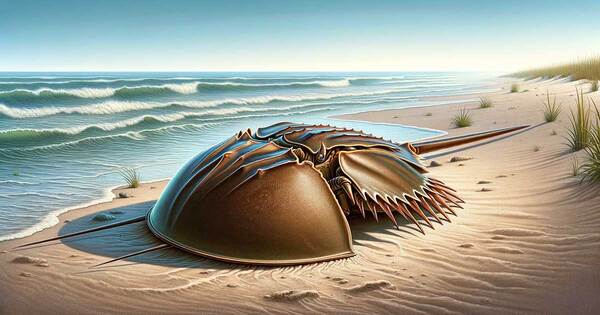Horseshoe crabs, with their ancient, prehistoric look, often raise curiosity among people: “Can you eat them?” While these creatures are primarily known for their ecological and medical significance, there are some contexts where they’re consumed. Let’s dive deep into whether horseshoe crabs are edible, what parts are eaten, cultural practices, and the potential risks and benefits of eating them.

Horseshoe crabs are marine arthropods, often mistaken for crabs but more closely related to spiders and scorpions. Found along coastlines in North America and Southeast Asia, these animals have been around for over 450 million years. Their ecological role is vital as their eggs are a food source for migratory birds, and their blue blood is used in the biomedical industry for testing bacterial contamination.
Yes, humans can eat horseshoe crabs, but not in the way you might think. Unlike common seafood like shrimp or fish, horseshoe crabs don’t have meat that’s easily consumable. Their primary edible component is their roe (eggs), which is used in certain Southeast Asian cuisines. However, it’s important to note that eating horseshoe crabs is not widespread and comes with risks.
Roe (Eggs): The eggs of some species, particularly the mangrove horseshoe crab (Carcinoscorpius rotundicauda), are considered a delicacy in places like Thailand and Malaysia.
Meat: Horseshoe crabs have a small amount of flesh, but it’s not commonly consumed due to its tough texture and limited quantity.
Tough Meat: Unlike crabs or lobsters, horseshoe crabs have little edible meat, and what they do have is rubbery and not very flavorful.
Potential Toxicity: Some species can be poisonous, as their eggs and flesh may contain toxins that can cause food poisoning if not prepared properly.
Ecological Importance: Horseshoe crabs are critical to ecosystems, and overharvesting could disrupt these delicate balances.
Legal and Conservation Issues: In many regions, harvesting horseshoe crabs for food is restricted or prohibited to protect their populations.
In Southeast Asia, particularly Thailand and Malaysia, horseshoe crabs are sometimes eaten as part of traditional cuisine. Dishes like "Yum Khai Maeng Da" (spicy horseshoe crab egg salad) are popular in coastal areas. The roe is prized for its texture and slightly briny flavor. However, not all species are safe to eat, and careful preparation is crucial.
While the roe is generally edible, consuming horseshoe crabs can be risky. Some species, like the Atlantic horseshoe crab (Limulus polyphemus), are not safe to eat as their eggs can contain toxins. Symptoms of poisoning include nausea, vomiting, and neurological issues. Always consult local guidelines and experts before attempting to eat these animals.
Harvesting the Roe: Carefully extract the eggs, ensuring no toxins are present.
Preparation: The roe is often boiled or mixed into spicy salads.
Cooking Methods: The eggs are typically served with chili, lime, and herbs in Southeast Asian cuisine.
Protected Status: In many regions, horseshoe crabs are protected due to their ecological and medical importance. For example, in the United States, it’s illegal to harvest horseshoe crabs in certain areas.
Conservation Efforts: Overharvesting for food or bait has caused population declines, leading to strict regulations in several countries.
Sustainability Concerns: Eating horseshoe crabs can have significant ecological impacts, particularly for migratory bird species that depend on their eggs for survival.
| Aspect | Details |
|---|---|
| Edible Parts | Primarily roe (eggs); meat is minimal and tough. |
| Common in Cuisine | Southeast Asia (Thailand, Malaysia). |
| Taste | Roe is briny and slightly nutty; meat is bland and chewy. |
| Risks | Possible toxicity, ecological concerns, and legal restrictions. |
| Preparation Methods | Boiled roe, spicy salads, or mixed with herbs and chili. |
| Non-Edible Factors | Limited meat, ecological importance, and medicinal significance. |
1. Can you eat horseshoe crab roe?
Yes, the roe of some species is edible and used in Southeast Asian cuisine.
2. Is eating horseshoe crab sustainable?
In most cases, no. Overharvesting can harm ecosystems and deplete populations.
3. Are horseshoe crabs poisonous?
Certain species can be toxic, particularly if their eggs or flesh are consumed without proper preparation.
4. Why aren’t horseshoe crabs commonly eaten?
Their tough texture, limited meat, and ecological significance make them an uncommon food choice.
5. Are horseshoe crabs consumed in the U.S.?
No, they are not part of American cuisine and are protected in many areas.
While it’s possible to eat horseshoe crabs, they’re not a common or practical food source. Their limited edible parts, potential risks, and ecological importance make them more valuable alive than on a plate. If you’re curious about trying them, consider the cultural and ecological implications and consult local regulations. For most people, it’s better to appreciate horseshoe crabs for their unique role in nature and science rather than as a culinary experiment.
animal tags: Horseshoe-Crabs
We created this article in conjunction with AI technology, then made sure it was fact-checked and edited by a Animals Top editor.